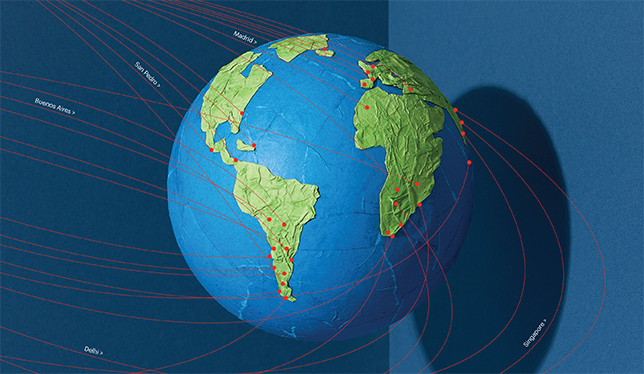When Anna Claire Sorensen arrived in Australia last December to study at Melbourne’s Deakin University, the 20-year-old’s biggest concern was the intense bushfires that had been raging nationwide for months. An undergraduate in English at Memorial University, she’d worked with a resource person there, called a mobility coordinator, to identify dangerous areas before leaving. She felt confident she could handle whatever came up – she was an experienced traveller and had extended family living not far from the Deakin campus.
Then came COVID-19. When Ms. Sorensen began classes at Deakin on March 9, the pandemic seemed a background concern, rather than an immediate threat. But, by the following week, classes had moved online and on March 16, Prime Minister Justin Trudeau was calling on Canadians to return home. Since Ms. Sorensen had planned to be in Australia for two full semesters – and had family to bunk with in a worst-case scenario – she didn’t immediately heed the call. But soon after, as the campus emptied and travel within Australia became uncertain, Ms. Sorensen decided to leave.
“Looking back on it now, my thinking was very much ‘we’ll see how it progresses,’” she says. “It was a personal feeling, like ‘I’ve come so far, and I don’t want to let go yet.’ But it became obvious that if I didn’t I might not have another chance.”
Ms. Sorensen wasn’t alone in hedging. From the federal government to university administrators to individual students, few anticipated how fast COVID-19 would sweep across the world, and everyone seemed to be operating at least a little behind the curve. In its speed and intensity, the onset of the COVID-19 pandemic was possibly the most daunting test ever of Canadian universities’ “duty of care” to students abroad.
The good news is that universities by and large passed the test. That’s thanks to a study-abroad infrastructure that has in recent years become far more robust, fortified by lessons learned during past emergencies, from 9/11 to SARS. COVID-19 looks set to be another such learning experience.
“There has never been a situation that has brought universities more together nationwide in a collective response,” says Larissa Bezo, CEO of the Canadian Bureau for International Education. “I hope that isn’t just about this crisis.”
A collective response will be especially important should the federal government’s ambitious international education strategy bear fruit. Since 2010, the number of international students at Canadian universities has grown by 150 percent, according to CBIE, yet the percentage of Canadians studying abroad has flatlined. A 2017 report by the Study Group in International Education (comprising educators, business executives and Canadian policy experts) found only 11 percent of Canadian undergraduates studied abroad during their academic career, far below countries like France (33 percent) and Germany (29 percent), and even below more geographically isolated nations such as Australia (19 percent).
The government’s new strategy commits $150 million until 2024 to remedy that, increasing access to international education and diversifying students’ destinations. And while the timeline will certainly be delayed due to COVID-19, the strategy remains in place. If successful, it will eventually see thousands more Canadian students travelling every year to a greater variety of countries – making universities’ duty-of-care responsibilities weigh more heavily than ever.

Universities aren’t supposed to be parental substitutes, but the idea of duty of care, according to Theresa Shanahan, is rooted in that very idea. A lawyer and associate professor in York University’s faculty of education, Dr. Shanahan explains that until the 1960s, duty of care was based on the principle of in loco parentis – the university standing in for mom and dad. “This is a very old view that can be traced back to the medieval university’s relationship with students,” she says. While it may seem dated, it still informs legal precedent, making universities potentially liable for perceived negligence.
Lawyer Ken Hall is president of Robertson Hall Insurance Inc. in London, Ontario, and works with churches, colleges and NGOs on duty-of-care concerns. An important factor when weighing duty-of-care cases, he says, is the idea of “foreseeability.” “If an organization like a university places a student in danger because they lack some information about risks,” he says, “that’s no defense if that information could have been found out easily by a reasonable investigation.”
Complicating things further is the potential for criminal liability. In 2004, Bill C-45 amended Canada’s Criminal Code to impose new penalties on organizations for violations resulting in injury or death. (It came in response to 1992’s Westray mine disaster, in which 26 coal miners in Nova Scotia were killed.) The bill expanded the duty-of-care burden from employers to any “association of persons.” That opened at least the hypothetical possibility of a criminal case being brought before a university, nullifying liability coverage a university might have against damages.
Fortunately, Canadian universities have largely avoided high-profile international tragedies (and legal repercussions) like those that have frequently made headlines in the United States. In 2018, the University of Minnesota paid $137,500 to a student who said she was raped by an interpreter hired by her study-abroad program while studying in Cuba. In 2017, parents of a University of Wisconsin student who died while studying at John Cabot University in Rome sued the university, reaching a settlement in 2019. And one of the most famous cases involved Ravi Thackurdeen, a student who drowned in Costa Rica in 2012 while on a program affiliated with Duke University. Mr. Thackurdeen’s parents, who eventually settled their lawsuit with the university, have become part of a nationwide movement to better track American student deaths abroad.
Canadian schools, of course, see far fewer students fanning out globally, making for fewer opportunities for danger to strike. But Canadian universities are also better prepared than ever. Students have access to staff and resources pre-departure, are given advice and information about where they’re travelling, and are kept in contact with their institutions post-departure. It’s a marked change from a not-so-distant past.
Lynne Mitchell has been the international liaison officer at the University of Guelph since 2010, but managed study abroad in the 1990s as well. “I remember one professor in the early ’90s saying, ‘I don’t do pre-departure orientation. It takes away the fun of finding out what the world is like!’” recounts Dr. Mitchell. “That idea wasn’t pervasive, necessarily, but there was much more a sense of, ‘if you sign a waiver, everything will be fine, and off you go.’” Those days are long gone.
“Study abroad was always very decentralized; each academic unit ran their own program.”
The University of British Columbia’s advisor for student safety abroad, Laurinda Tracey, has been on the job for 10 years. In a normal year, she oversees upwards of 3,000 students travelling to more than 250 partner institutions. “We’ve dealt with earthquakes and tsunamis, bombings and terrorism, the Charlie Hebdo attacks in France,” she says, “a lot of major international events.”
UBC isn’t alone in dealing with high-profile emergencies. In 2011, the University of Calgary scrambled to track down 10 of its students after Japan’s Tōhoku earthquake and tsunami; and, in 2019, several Canadian universities had to quickly repatriate students from Hong Kong during the protests that swept through that city’s campuses. Each one of these emergencies has prompted institutions to revisit and improve risk management.
At Memorial University, the H1N1 flu pandemic in 2009 provided the trigger to overhaul things. “Study abroad was always very decentralized; each academic unit ran their own [program],” says Sonja Knutson, director of Memorial’s internationalization office. “My office didn’t really do very much in terms of risk management. Nobody did. When H1N1 hit, it was like, ‘Oh, we don’t actually know where our students are.’”
After that pandemic, Ms. Knutson was given the job of managing study-abroad risk and overhauled the university’s entire approach, creating a database of all students abroad and developing an online preparatory course. The plan was modelled in part on the system in place at Queen’s University and in part after a book on managing study-abroad risk written by Wayne Myles, retired director of the Queen’s University International Centre, and U of Guelph’s Dr. Mitchell.
At the University of Regina, improvements in risk-mitigation have accompanied a dramatic increase in study abroad. Of the university’s 16,000 students, nearly 500 travelled abroad in the 2018-2019 academic year. Ten years ago, it was only nine. Back then, the university didn’t even conduct risk assessments of foreign locations, says Livia Castellanos, the university’s chief international officer (currently on leave). Today it uses Global Affairs Canada’s four-tiered risk assessment of foreign countries as a jumping-off point – as do most universities – then complements that with in-house analysis. (See the sidebar, “Know the risk,” outlining Global Affairs’ four travel advisory levels.)
At larger universities with a longer legacy of international travel, risk management has traditionally been more robust, but has still seen expansion. In the early 2000s, York, Queen’s and U of Guelph jointly developed an online pre-departure system called DepartSmart, which provides background information and contacts for consulates in various countries, and training and guidance on safe travel. The system was rolled out post-9/11 and became a valuable resource in that anxious era of international travel.
“Depending on the Global Affairs assessment for a destination, students are now required to do different things,” says Ms. Tracey at UBC. “For destinations that are lower-risk, students just have to complete the safety-abroad registry and ensure they have insurance. But we have another process for high-risk travel requests.” In those cases, students must identify the academic necessity of their trip and develop a thorough risk-mitigation plan.
Pirita Mattola, manager of the International Student and Study Abroad Centre at the University of Saskatchewan, says higher-risk travel is only open to graduate students at her university. “We pay close attention to the academic rationale and see if there are viable options to do that work in a safer place. … It would be a multi-step process to approve that, reviewed by the dean and approved by the university provost.”
As important as it is to assess risk associated with destinations, universities have also become more stringent about evaluating students’ individual preparedness. After all, says Ms. Tracey, headline-grabbing disasters get the most attention, but more common are one-off incidents: students who become victims of crime, have an accident, get lost, end up in unsafe accommodations or suffer mental-health difficulties far from home.
“When we’re advising students, they might tell us they’ve never visited anywhere but Alberta,” says Ms. Castellanos. So maybe sending them to Japan for two months is a bit too much, too soon. … We’ve learned that kind of thing through hard experience.”
Just as it has on campus generally, mental-health concerns have become a cornerstone of study-abroad duty of care. A study by International SOS, an organization which works with more than 40 Canadian universities to provide “duty of care support,” from medical care to security services to evacuation and repatriation, has found that student travellers are 23 times more likely than business travellers to require repatriation due to a mental-health condition.
Ms. Knutson says Memorial experiences about one study-abroad emergency per year, usually a mental-health issue. To fill that gap in care, for mental-health issues among others, most universities rely on their partner institutions internationally, but may also work with international insurers such as guard.me, which provides counselling services, or International SOS.
The latter company was also critical to some universities’ COVID-19 response. In March, UBC returned nearly 700 students to Canada, including from China and Italy, the pandemic’s initial hotspots. “The World Health Organization put out daily situation reports,” says Ms. Tracey, “but relying on additional forces like SOS, where you can get fast on-the-ground intelligence, has been really helpful.”
For Dr. Mitchell, it was her Apple Watch – set to buzz at local news alerts pertaining to U of Guelph students’ locations – that kept her up to speed as the pandemic flared first in one country then another. “I was lucky that I dealt with SARS years ago,” she says. “That was a bit of a practice run, and that’s when we really started to track centrally where students are in the world and really taking on more of that institutional responsibility.”
That centralization made dealing with the stressful first weeks of the COVID-19 response easier. On March 16, when Global Affairs Canada raised its threat level for the entire world to level three (avoid non-essential travel), Dr. Mitchell still had 165 students abroad. Unlike during SARS, she was able to quickly get in touch with everyone, and the university eventually repatriated 148 students. A few remained abroad due to personal circumstances, such as having family in foreign locations.
Keeping in regular and consistent contact with students throughout the crisis was key, says Dr. Mitchell. “In the end I think students felt our office was a group of people trying to help them, not just an admin unit doing procedural work. We were in touch early and often and formed real relationships with students. I think that’s a big lesson for future situations.”
“What I have learned from this is that we cannot take anything for granted,” says Ms. Castellanos at U of Regina. “We cannot be unprepared for unthinkable things.” Despite a relatively successful response, Ms. Castellanos says she’s already thinking of how to strengthen the duty-of-care response in the future. “In the past I didn’t think we would need to work with a company like International SOS,” she says, “but I’m rethinking that.”
The question hanging over universities now is whether a newfound risk aversion, caused by the current pandemic, may put a long-term crimp in study abroad’s popularity. Doug Weir, executive director of student programs and services at the University of Alberta’s international office, doesn’t think so. “Students’ interest in being out in the world is definitely going to continue when this is over.”
Dr. Mitchell agrees, and notes that managing anxiety about risk has been a constant throughout her career. She anticipates that COVID-19 will again put safety on the front burner but is unlikely to threaten travel in the long term once the pandemic is over.
“People have always been worried about things like coups and poisonous snakes, but the truth is that traffic accidents kill more travellers than anything else,” she says. “The risks abroad are often very similar to the risks at home. If students, parents and the university take the right steps to manage them, the opportunities travel creates more than outweigh those risks.”
Know the risk
Global Affairs Canada applies one of four possible risk levels to a country, territory or region:
1. Exercise normal security precautions
There are no significant safety and security concerns. The overall safety and security situation is similar to that of Canada.
2. Exercise a high degree of caution
There are identifiable safety and security concerns, or the safety and security situation could change with little notice. Monitor local media and follow the instructions of local authorities.
3. Avoid non-essential travel
There are specific safety and security concerns that could put you at risk. You should reconsider your need to travel to the country, territory or region. If you are already in the country, territory or region, you should reconsider whether or not you really need to be there. If not, you should consider leaving while it is still safe to do so.
4. Avoid all travel
There is an extreme risk to your personal safety and security. You should not travel to this country, territory or region. If you are already in the country, territory or region, you should consider leaving if it is safe to do so.

